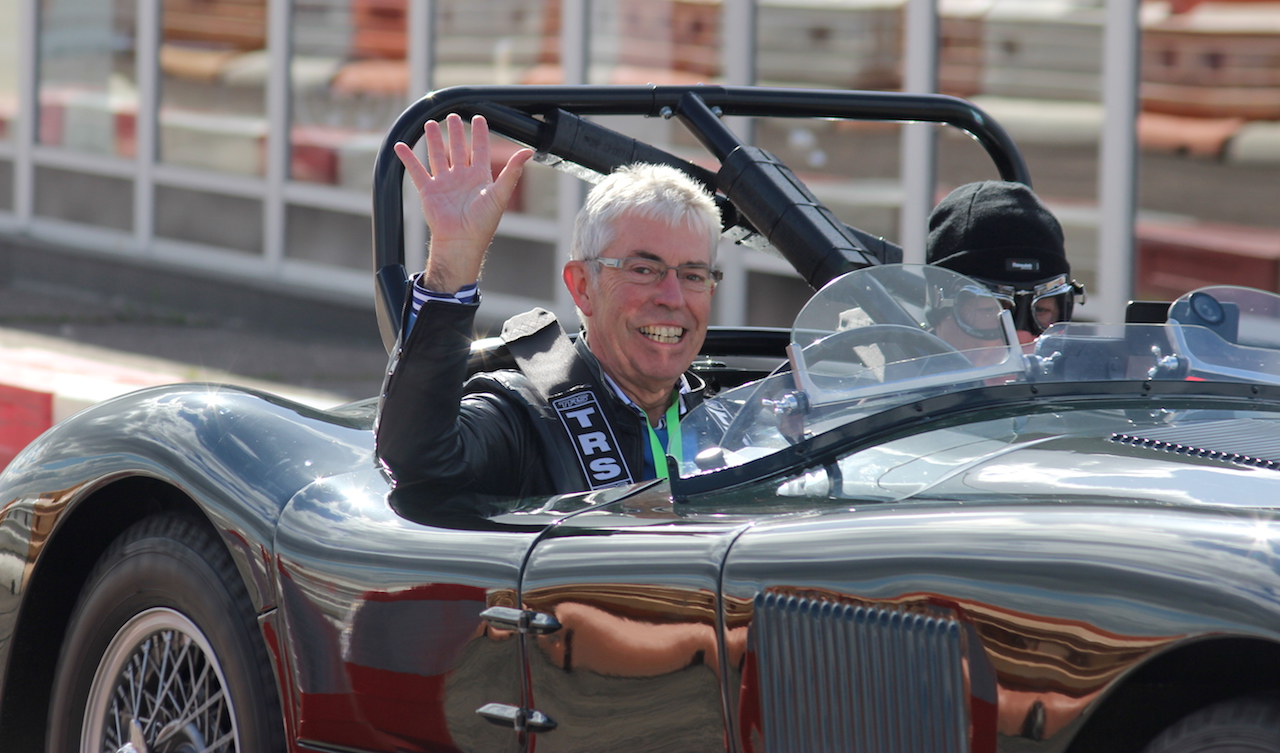A couple of months back Dave Flyn, who runs a well-known fit-out company, called me saying “Clear your diary for September 25th”. “Why?” said I. “Factory visit” came the response. We do a fair bit of that in our line of work, so no surprises there then. Something to look forward to, since Dave is well renowned for his entertainment skills even when making a humble trip to a supplier.
Two months later, with less than 48 hours to go, still no word from Dave. So a brief phone call elicited that the trip was still on. “Oh, and where are we going?” I hurriedly inquired. “Browns Lane, Jaguar Heritage – all expenses paid” came the answer. However Dave had a bad bout of food poisoning and couldn’t make it, so I should go and take someone else along; Steve Potter, a recent XJS owner would be the lucky fellow. “Be at the rendezvous at 09.30 hours Friday and they’ll take it from there. Have a good time.”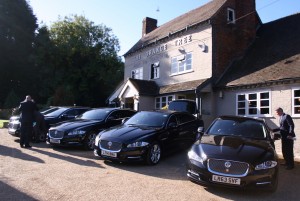
Sitting beside the Warwick Road and nestling in Chadwick End, a leafy suburb of Solihull, is the Orange Tree, an up-market pub restaurant; it was here, at the appointed hour, that we met our hosts for the day and fellow travellers. Once we had downed the coffee and croissants, seven black XJ’s arrived to chauffeur all fifteen of us to our first stop, Browns Lane. This former WW2 shadow factory became the home of Jaguar Cars in 1951 and remained the source of our vehicles of choice until 2005, when car production ended. It is now largely given over to housing with place names such as Lyons Park and Swallows Nest as lasting reminders of times past. There is, however, still a part that will always be Jaguar, for it is here that Jaguar Heritage has opened a brand new workshop facility to undertake servicing and restoration work, both for their own heritage vehicles and for some owned by private individuals. Around the site you can see prototypes of new models, some disguised, some not. Unfortunately photography was banned, but once inside, your happy snappers were give a free reign.
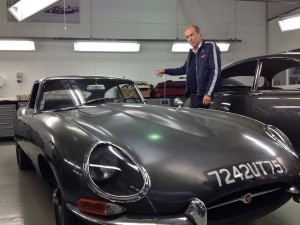 Harry Metcalf, founder and former editor of EVO Magazine and now, amongst many other interests, an ambassador for Jaguar Heritage (and owner of the first Project 7 sold), led us into the scrupulously clean workshop and introduced us to Kev Riches, the Heritage Recreation and Engineering Manager. He guided our group around a tantalising mix of classics, some undergoing restoration, some in the queue. And what a selection! An XJ220 with only a few hundred miles under the tyres was in for recommissioning, an immaculate XKSS, an XJR, XK120 through to XK150, a MK2 and several E Types were all receiving some form of treatment. One E Type had recently arrived from Paris – maybe a garage find – where it had been used as a daily driver all its life and had never been restored. Complete with the scars of Parisian driving displayed almost proudly, it was proving difficult to decide how much to do to it without losing its originality.
Harry Metcalf, founder and former editor of EVO Magazine and now, amongst many other interests, an ambassador for Jaguar Heritage (and owner of the first Project 7 sold), led us into the scrupulously clean workshop and introduced us to Kev Riches, the Heritage Recreation and Engineering Manager. He guided our group around a tantalising mix of classics, some undergoing restoration, some in the queue. And what a selection! An XJ220 with only a few hundred miles under the tyres was in for recommissioning, an immaculate XKSS, an XJR, XK120 through to XK150, a MK2 and several E Types were all receiving some form of treatment. One E Type had recently arrived from Paris – maybe a garage find – where it had been used as a daily driver all its life and had never been restored. Complete with the scars of Parisian driving displayed almost proudly, it was proving difficult to decide how much to do to it without losing its originality.
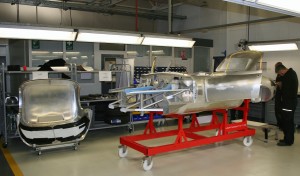 But what we really came to see was sitting in the far right of the workshop. Sparkling under the shop lights was the tub of the next Lightweight E under construction. Alongside was number 1, fully completed and the star of the recent TV documentary, now on loan from its American owner who, like the other lucky owners, paid over £1 million for the privilege of owning one of the last six official factory lightweights.
But what we really came to see was sitting in the far right of the workshop. Sparkling under the shop lights was the tub of the next Lightweight E under construction. Alongside was number 1, fully completed and the star of the recent TV documentary, now on loan from its American owner who, like the other lucky owners, paid over £1 million for the privilege of owning one of the last six official factory lightweights.
So, why are they that special? As Kev Riches explained, each part is minutely scanned and recreated before assembly, sometimes using original tooling. The all-aluminium body is handcrafted making it one of the most iconic cars ever produced. Six cars in total will be sold, each representing one of the missing models from the allotted eighteen which did not make production in 1963. There is one prototype, but this does not carry the coveted chassis number.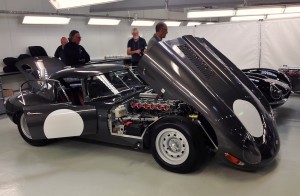 Each vehicle is built to the same specification as the original twelve, the last of which left the factory in 1964. The only difference being the larger front brakes, for health & safety and all that! A high performance version of the renowned XK straight six, which can be tweaked to the owner’s preference, powers the car which is 114Kg lighter than a standard E Type. So, with 340 horses below the bonnet, it should be, well, fast. The car qualifies for FIA historic races and no doubt some customers will take full advantage of this. When I asked Kev about Lord March’s comments that it was a replica and not suitable for Goodwood, he said that it was neither a recreation nor a replica, but rather a continuation using the same materials, skills, tools, plans, factory and the remaining chassis numbers. It’s just that the guys making them had a very long lunch break!
Each vehicle is built to the same specification as the original twelve, the last of which left the factory in 1964. The only difference being the larger front brakes, for health & safety and all that! A high performance version of the renowned XK straight six, which can be tweaked to the owner’s preference, powers the car which is 114Kg lighter than a standard E Type. So, with 340 horses below the bonnet, it should be, well, fast. The car qualifies for FIA historic races and no doubt some customers will take full advantage of this. When I asked Kev about Lord March’s comments that it was a replica and not suitable for Goodwood, he said that it was neither a recreation nor a replica, but rather a continuation using the same materials, skills, tools, plans, factory and the remaining chassis numbers. It’s just that the guys making them had a very long lunch break!
As a final bit of theatre, and with some flourish, Kev pulled the black cover from a car on a nearby ramp to reveal Light weight E Type number 3 (I think), all ready for its new owner. Looking underneath, it was as clean and well detailed as the rest of the car. Perfect for those unplanned roll overs.
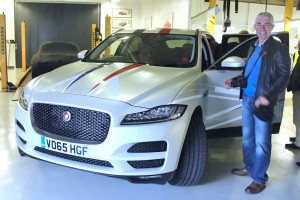 We were expecting the E, but a surprise was waiting for us in the form of the new F-Pace. Not yet in the showrooms, it was the first time most of us had been up front and personal with one. This was a prototype that had been on the show circuit, hence the pearlescent white wrap. Kevin Stride (another Kevin, it must be a Midlands thing) the Line Director/Project Manager and parent to it over the last four years’ gestation, took us round. Sitting on 22 inch wheels, with ultra-low profile tyres, it did strike a good pose with the Jaguar DNA shouting its presence. If 4×4 SUVs are your thing, then this must be high on your list. Kevin explained that the chassis was conceived for the F-Pace without compromises, with double wishbone front suspension and integral multi-link rear, similar to that of the XF. Size-wise, it sits between the Audi Q5 and Q7, but avoids the bulkiness of both. An interesting feature for the traditionalists is that the standard instruments are analogue dials, although a TFT virtual set-up can be specified. If you desire any more technical stuff, go to this month’s JEC magazine where you will find the full fat technical debrief. Not all was smooth running for this project, however. As Kevin related, just when they were nearing completion, Porsche (them again) brought out the Macan. This really was an “Oh Dear!” moment for the team, resulting in some re-engineering which, we were told, Tata generously funded without argument, thus ensuring the F-Pace was ahead of the game. With eight of Porsche’s ten car range achieving five star ratings – the Macan is one – it will be a close run thing but, on looks alone, I would take the Jag any time.
We were expecting the E, but a surprise was waiting for us in the form of the new F-Pace. Not yet in the showrooms, it was the first time most of us had been up front and personal with one. This was a prototype that had been on the show circuit, hence the pearlescent white wrap. Kevin Stride (another Kevin, it must be a Midlands thing) the Line Director/Project Manager and parent to it over the last four years’ gestation, took us round. Sitting on 22 inch wheels, with ultra-low profile tyres, it did strike a good pose with the Jaguar DNA shouting its presence. If 4×4 SUVs are your thing, then this must be high on your list. Kevin explained that the chassis was conceived for the F-Pace without compromises, with double wishbone front suspension and integral multi-link rear, similar to that of the XF. Size-wise, it sits between the Audi Q5 and Q7, but avoids the bulkiness of both. An interesting feature for the traditionalists is that the standard instruments are analogue dials, although a TFT virtual set-up can be specified. If you desire any more technical stuff, go to this month’s JEC magazine where you will find the full fat technical debrief. Not all was smooth running for this project, however. As Kevin related, just when they were nearing completion, Porsche (them again) brought out the Macan. This really was an “Oh Dear!” moment for the team, resulting in some re-engineering which, we were told, Tata generously funded without argument, thus ensuring the F-Pace was ahead of the game. With eight of Porsche’s ten car range achieving five star ratings – the Macan is one – it will be a close run thing but, on looks alone, I would take the Jag any time.
Before we knew it, lunch time was upon us. Once again, we were ferried by those black Jaguars to the Orange Tree for a very satisfying, if alcohol-free, lunch. My main course was a Flat-iron steak, one of the best I’ve tasted, all washed down with water and ginger beer. Hmmm. Luckily, we were not on a cookery course, so back to the cars!
Jag day part two took us to Fen End near Wroxhall. Set in two hundred acres of Midlands countryside, previously known as Honiley Airfield and used by the RAF since 1941, it is now home to the Jaguar Heritage Experience. Open during the summer months, it contains a hospitality suite housing a small, but perfectly stocked museum, a lecture theatre, refreshment facilities, goodie store, oh…and a few interesting cars just outside.
Set out before us were: a Range Rover SVR, an F-Type R, a Project 7, a be-winged XKR, a C and D type, a V12 E Type Roaster, an XK 150, and a Coombs 3.8 Mk 2, formerly driven by Graham Hill. It doesn’t get better than this!
First on the track was your scribe but, amazingly, not in a Jaguar. Waiting on the tarmac was a blue Rangie. If 4×4 SUVs float your boat, then it has to be a Range Rover and there is none better than the SVR 5.4 litre, with 540 wild horses waiting to be unleashed. Once aboard and cocooned in that sumptuous cream leather-clad cabin it was time to push that button….and that’s when all thoughts of regally wafting round the track ended! This beast must have been developed by NASA. The head up display relentlessly rolled over the numbers at intervals of less than a second. Within the blink of an eye I was reading 93mph on the straight and I was rapidly running out of, well, straight. Thank God for good brakes! The soundtrack matched the performance. You remember the sound of Frank Bullitt’s Mustang? This was its equal. Yup, if I ever did buy a 4×4, this would be the one.
What could top that? Try an F Type R…which I did. With 543 bhp on tap, an uprated chassis, this ferocious coupe is a blast. The noises are similar to the Range Rover, but it feels quicker and eats that track as if you were out for a Sunday ride to the church. But it doesn’t end there. My instructor passenger suggested I push the switch on the centre console before the second lap. This was Sport Mode – or the Widow Maker, he joked. The TFT screen showed a silhouette of the car with all manner of suspension and engine components turning the devil’s red. The feeling was that of the car hunkering down, with the steering tightening ready for a good thrashing. That was soooo good! Later at the end of the day, we were allowed to choose a car in which to be professionally driven around the track. This is the one I chose. What a ride!!! Try before you die.
 Project 7 was definitely on my list. Jaguar have made a limited run of 250 of these and, as Harry was not going to let us drive his any time soon, it was fortunate that they had a production prototype on hand ready to have some fun with. The roof, if you ever use it, may take about 20 minutes to erect, but that’s the only slow thing about this car. Manufactured to honour Jaguar’s seven Le Mans wins, this 567bhp beast cracks into life at the push of a button and just keeps on accelerating until you finally lose your nerve or run out of track. It even has a “Dynamic Mode” … the speed no doubt measured in parsecs! Yours for around £135k, they are all sold out.
Project 7 was definitely on my list. Jaguar have made a limited run of 250 of these and, as Harry was not going to let us drive his any time soon, it was fortunate that they had a production prototype on hand ready to have some fun with. The roof, if you ever use it, may take about 20 minutes to erect, but that’s the only slow thing about this car. Manufactured to honour Jaguar’s seven Le Mans wins, this 567bhp beast cracks into life at the push of a button and just keeps on accelerating until you finally lose your nerve or run out of track. It even has a “Dynamic Mode” … the speed no doubt measured in parsecs! Yours for around £135k, they are all sold out.
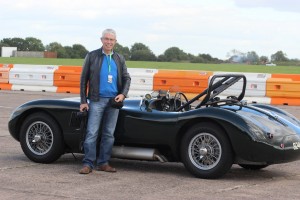 Enough of the modern stuff, bring on some classics … and that’s just what they did. Before us stood a V12 E Type Roadster, a C and D Type and a Coombs Mk 2. DOT the C Type was my first choice. “Don’t push yourself in with your hand on the wing, it’ll dent the alloy … No, don’t heave on the steering wheel, it will break…”. Have you ever tried getting into one of these things without doing this? Thought not! Once ensconced behind the healthily intact steering wheel, I was instructed not to let it stall and by a careful use of the gears, I should succeed. Well, I used to drive old cars as a youth so, no sweat, we tootled out to the track without so much as a cough let alone a splutter. I could almost feel that smugness envelope me like a warm fog. “Not much legroom” I observed as my feet were almost bent backwards on the pedals. “Well, Stirling Moss wasn’t very tall” came the well-rehearsed reply. But what a brilliant feeling racing round the track in this machine. You need to drive this yourself. There are no electronic aids to help you here. Great fun and 60mph felt like you were doing 90!
Enough of the modern stuff, bring on some classics … and that’s just what they did. Before us stood a V12 E Type Roadster, a C and D Type and a Coombs Mk 2. DOT the C Type was my first choice. “Don’t push yourself in with your hand on the wing, it’ll dent the alloy … No, don’t heave on the steering wheel, it will break…”. Have you ever tried getting into one of these things without doing this? Thought not! Once ensconced behind the healthily intact steering wheel, I was instructed not to let it stall and by a careful use of the gears, I should succeed. Well, I used to drive old cars as a youth so, no sweat, we tootled out to the track without so much as a cough let alone a splutter. I could almost feel that smugness envelope me like a warm fog. “Not much legroom” I observed as my feet were almost bent backwards on the pedals. “Well, Stirling Moss wasn’t very tall” came the well-rehearsed reply. But what a brilliant feeling racing round the track in this machine. You need to drive this yourself. There are no electronic aids to help you here. Great fun and 60mph felt like you were doing 90!
The Mk2 was more familiar, since it is the basis for the 420.  So how hard could this one be? Quite hard, actually. Stripped of its creature comforts, 779 XKT was basically a Mk 2 shell with an engine and a couple of seats. But did it go! The first thing that struck me as I wrestled it round a bend was that there was no power steering and that the chicane was rapidly approaching. I was soon sweating. The car and, thankfully, its occupants did make it. The next lap was easier, but respect for those boys who raced these machines for hours on end. We have it too easy! This white example was Graham Hill’s racer. There I go name-dropping again.
So how hard could this one be? Quite hard, actually. Stripped of its creature comforts, 779 XKT was basically a Mk 2 shell with an engine and a couple of seats. But did it go! The first thing that struck me as I wrestled it round a bend was that there was no power steering and that the chicane was rapidly approaching. I was soon sweating. The car and, thankfully, its occupants did make it. The next lap was easier, but respect for those boys who raced these machines for hours on end. We have it too easy! This white example was Graham Hill’s racer. There I go name-dropping again.
Eventually we had to bid farewell and return to the Orange Tree for drinks and sandwiches before the journey home. Do go on one of these if you are able; you won’t regret it. And thank you, Dave, for inviting me even if you couldn’t make it yourself.
Neil Shanley

